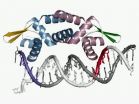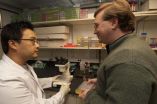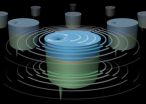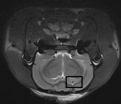(Press-News.org) If you pull up a soybean or bean plant and shake off the dirt, you might see odd swellings or bumps, like rheumatic finger joints, on its roots. Inside the cool, soil-covered bumps are bacteria that are making nitrogen with the help of an enzyme, something chemical factories can do only with the help of a catalyst and at high temperature and pressure.
The bacteria, typically members of the genus Rhizobia, break the strong triple bond between the nitrogen molecules in the air and repackage the nitrogen atoms in chemical compounds the plant can use. In return, the plant supplies the bacteria with the energy needed to split the nitrogen molecules in the form of sugar.
Legume-Rhizobia partnerships generate more nitrogen for plants than all industrial fertilizers used today, and they provide the right amount of nitrogen at the right time.
By contrast, much of the synthetic fertilizer applied to farm fields is wasted, washing out the soil into waterways or evaporating into the atmosphere in the form of nitrous oxide, where it becomes an environmental and health risk.
Farmers can already buy Rhizobia-rich biofertilizers to increase nodule formation and improve soil quality without synthetic fertilizers. But scientists are beginning to talk about re-engineering crop plants so that, like legumes, they will have on-site nitrogen-fixing systems, either in root nodules or in the plant cells themselves.
To do that, scientists need to understand the biological nitrogen-fixing machinery as thoroughly as a mechanic understands the valves and pistons of a car engine. The difference is that the biological machinery is far too small to be visible to the unaided eye.
Science got one step closer to this goal recently when a team at Washington University in St. Louis worked out the structure of a protein called NolR that acts as a master off-switch for the nodulation process. By building an accurate atomic model of the protein, they were able to "see" exactly how it recognizes and slots itself into genes to prevent bacteria from embarking on a life as a symbiont. The work was published in April 29 issue of PNAS,
Trust but verify
The process of nodulation is so weird that if you read about it in a science fiction book, you'd probably credit the author with a great imagination.
First, the plant and soil bacteria engage in a molecular dialog to make sure they are compatible partners. The host plant releases a cocktail of chemicals called flavonoids that are perceived by a bacterial protein named NodD, which turns on nod (nodulation) genes. Together the nod genes make a large, complicated molecule called a nod factor.
The nod factor triggers the plant to make an"infection thread," or a tube through which the bacteria travel deep into the root, where they are wrapped in membrane the plant has synthesized and sequestered in vesicles within the root cortex cells of a nodule. Their metabolism and even their ability to reproduce are so altered that they are like different organisms, and are called bacteroids rather that bacteria.
"It's like a pathogen invasion," said Joseph Jez, PhD, associate professor of biology in Arts & Sciences at Washington University, "but Rhizobium is not a pathogen, it's a beneficial organism. "
Does it curl or lie flat?
Scientists working on the genetics of nodule formation in the mid-1980s and early '90s, identified NodD, a master on-switch for nod genes, and NolR, a master off- switch that acts even more broadly, turning off the nod genes, NodD, and other genes needed for life as a symbiont.
"The bacteria has the ability to turn on a bunch of genes for nodulation and the symbiosis, but it needs to keep them turned off as long as it is free-living," Jez said. "And that's the role of NolR."
"It's like driving a car," said Soon Goon Lee, PhD, postdoctoral research associate in the Jez lab. "NodD is the gas pedal and NolR is the brake. But we didn't know how NolR worked until we solved its structure and could understand how it interacted with DNA."
The job is to figure out how the long, thread-like protein molecule folds on itself to form a snarl of helices and ribbons, and then how the folded molecule fits into and binds with the DNA.
Unfortunately, protein folding is a notoriously hard problem, one as yet beyond the reach of computer calculations. So most protein structures are still solved by the time-intensive process of crystallizing the protein and then barraging the crystal with X-rays to locate the atoms within it.
VIDEO:
The helix-turn-helix motif of the protein NolR consists of alpha helices (pale blue and pink) separated by a short string of amino acids (the turn). The helices are spaced to...
Click here for more information.
In 2005, Hari R. Krishnan, PhD, a U.S. Department of Agriculture scientist at the University of Missouri-Columbia, told Jez that he had a NolR clone, or population of cells that all made the NolR protein. Would Jez be interested in trying to crystallize NolR so that its structure could be solved, Krishnan asked.
Jez happily accepted, and, as time permitted, he or another member of the lab would put NolR through a crystallization screen, depositing drops of the protein into little wells filled with different solutions, searching for conditions that would cause the protein to crystallize.
At first, NolR was uncooperative. If they got crystals, the crystals fell apart when they were manipulated or they produced diffraction patterns that couldn't be interpreted.
In his turn, Lee picked up the project. He decided to start at the beginning again, picking a DNA sequence NolR bound, ordering that snip of DNA, and then trying to crystal a mixture of the protein and DNA together.
This should have been harder than crystallizing the protein alone, but to his surprise it turned out to be easier. The low-resolution data Lee got for the protein/DNA complex made it easier for the scientists to interpret the high-resolution data from the protein alone.
The protein turned out to have what is called a helix-turn-helix motif commonly found in proteins that bind DNA. The DNA double helix has a major groove and minor groove that run down the double helix like the threads of a screw. Many proteins that bind to DNA do so through the wider major groove.
"The major groove is the one that's open, and you can fit a protein helix into that groove," Jez said. "So nature uses this helix-turn-helix domain as a way of positioning helices into the major grooves. The protein is a dimer, so it has two helices that are spaced perfectly to put one into each of two consecutive major grooves."
To act as a master switch, NolR has to be able to recognize and bind to many different genes. It's able to do that because each of the genes carries the same sequence of nucleotides, called a consensus sequence, somewhere along its length. In this case, there are two such sequences in consecutive major grooves in all the genes NolR binds.
The scientists are pleased with their progress but it has only made them more eager to crystallize the other protein: the on-switch, NodD. After all, it's hard to drive a car when you only have a brake but no accelerator.
INFORMATION: END
A protein key to the next green revolution sits for its portrait
NolR is a master off-switch for the process that converts bacteria from free living to nitrogen-fixing
2014-04-30
ELSE PRESS RELEASES FROM THIS DATE:
'Charismatic' organisms still dominating genomics research
2014-04-30
Decades after the genomics revolution, half of known eukaryote lineages still remain unstudied at the genomic level--with the field displaying a research bias against 'less popular', but potentially genetically rich, single-cell organisms.
This lack of microbial representation leaves a world of untapped genetic potential undiscovered, according to an exhaustive survey conducted by UBC researchers of on-going genomics projects. The survey results are published in the May issue of Trends in Ecology and Evolution.
"We're still mostly analyzing the same well-known eukaryotic ...
Deep origins to the behavior of Hawaiian volcanoes
2014-04-30
Kīlauea volcano, on the Big Island of Hawai'i, typically has effusive eruptions, wherein magma flows to create ropy pāhoehoe lava, for example. However, Kīlauea less frequently erupts more violently, showering scoria and blocks over much of the surface of the island. To explain the variability in Kīlauea's eruption styles, a team including Bruce Houghton, the Gordon Macdonald Professor of Volcanology in Geology and Geophysics at the University of Hawai'i at Mānoa (UHM) School of Ocean and Earth Science and Technology (SOEST) and colleagues from ...
New tool for Joint Lab to investigate the chemistry of nature
2014-04-30
This news release is available in German. HZB-scientist Emad Aziz, who leads the Joint lab between HZB and Freie Universität Berlin, has developed and installed a new tool to investigate ultrafast dynamics in solutions and at interfaces with the use of ultrashort Laser pulses. Liquid phases are a natural environment for many interesting processes in chemistry and biology, and short light pulses allow insights into electronic and structural dynamics of molecules and molecular complexes. In particular, photoelectron spectroscopy with extreme ultraviolet (XUV) radiation ...
Harnessing magnetic vortices for making nanoscale antennas
2014-04-30
UPTON, NY—Scientists at the U.S. Department of Energy's Brookhaven National Laboratory are seeking ways to synchronize the magnetic spins in nanoscale devices to build tiny yet more powerful signal-generating or receiving antennas and other electronics. Their latest work, published in Nature Communications, shows that stacked nanoscale magnetic vortices separated by an extremely thin layer of copper can be driven to operate in unison, potentially producing a powerful signal that could be put to work in a new generation of cell phones, computers, and other applications.
The ...
NOAA-led researchers discover ocean acidity is dissolving shells of tiny snails off West Coast
2014-04-30
A NOAA-led research team has found the first evidence that acidity of continental shelf waters off the West Coast is dissolving the shells of tiny free-swimming marine snails, called pteropods, which provide food for pink salmon, mackerel and herring, according to a new paper published in Proceedings of the Royal Society B.
Researchers estimate that the percentage of pteropods in this region with dissolving shells due to ocean acidification has doubled in the nearshore habitat since the pre-industrial era and is on track to triple by 2050 when coastal waters become 70 ...
Neiker-Tecnalia studies the effects of climate change on Tempranillo grape wines
2014-04-30
Climate change is set to affect the quality of the wines of the Tempranillo grape variety, according to the conclusions of a piece of research conducted by the Basque Institute for Agricultural Research and Development Neiker-Tecnalia, in collaboration with the University of Navarre and the Aula Dei (EEAD) Experimental Station of the National Council for Scientific Research (CSIC). Scientists from these bodies have studied the behaviour of the vines in conditions of climate change; in other words, higher temperature, increased presence of CO2 and greater environmental aridity. ...
7.0T NMR assesses changes in hippocampal neurons in animal models of Alzheimer's disease
2014-04-30
Magnetic resonance spectroscopy can quantitatively analyze in vivo abnormalities of biochemical metabolism within brain tissue in a noninvasive and non-radioactive manner. Compared with 3.0T magnetic resonance spectroscopy, high-field magnetic resonance spectroscopy (≥ 7.0T) exhibits high spatial resolution and density resolution, microscopic imaging of the living body, and obtains both high scanning resolution and result precision within a shorter scan time, thus providing a higher value in clinical diagnosis. In a recent study reported in the Neural Regeneration ...
A researcher from the University of Cádiz discovers 18 new species of molluscs
2014-04-30
Molluscs are invertebrates that make up one of the most numerous groups in the animal kingdom. They are everywhere, from great heights of over 3,000m above sea level to ocean profundities of over 5,000m deep, in polar and tropical waters and they tend to be common elements on coastlines around the world. Within this animal group are found the nudibranchs, characterized among other things, for not having shells and being brightly coloured. This colouring alerts their predators to their toxicity. Within this group, in turn, we can find the Aeolidiidae family.
This family ...
Deep brain stimulation for obsessive-compulsive disorder releases dopamine in the brain
2014-04-30
Philadelphia, PA, April 30, 2014 – Some have characterized dopamine as the elixir of pleasure because so many rewarding stimuli – food, drugs, sex, exercise – trigger its release in the brain. However, more than a decade of research indicates that when drug use becomes compulsive, the related dopamine release becomes deficient in the striatum, a brain region that is involved in reward and behavioral control.
New research now published in Biological Psychiatry from the Academic Medical Center in Amsterdam suggests that dopamine release is increased in obsessive-compulsive ...
Candid 'insider' views in the NHS could help detect reasons for poor care
2014-04-30
Asking NHS staff about what affects whether they would recommend their organisation for family and friends is an important source of intelligence for improving quality and safety of care, says a new study.
This finding by researchers in the Universities of Leicester, Aberdeen, and Bristol has been published in a paper, 'The friends and family test: a qualitative study of concerns that influence the willingness of English National Health Service staff to recommend their organisation', in the Journal of the Royal Society of Medicine.
Since 2009, the annual Staff Survey ...
LAST 30 PRESS RELEASES:
Making lighter work of calculating fluid and heat flow
Normalizing blood sugar can halve heart attack risk
Lowering blood sugar cuts heart attack risk in people with prediabetes
Study links genetic variants to risk of blinding eye disease in premature infants
Non-opioid ‘pain sponge’ therapy halts cartilage degeneration and relieves chronic pain
AI can pick up cultural values by mimicking how kids learn
China’s ecological redlines offer fast track to 30 x 30 global conservation goal
Invisible indoor threats: emerging household contaminants and their growing risks to human health
Adding antibody treatment to chemo boosts outcomes for children with rare cancer
Germline pathogenic variants among women without a history of breast cancer
Tanning beds triple melanoma risk, potentially causing broad DNA damage
Unique bond identified as key to viral infection speed
Indoor tanning makes youthful skin much older on a genetic level
Mouse model sheds new light on the causes and potential solutions to human GI problems linked to muscular dystrophy
The Journal of Nuclear Medicine ahead-of-print tip sheet: December 12, 2025
Smarter tools for peering into the microscopic world
Applications open for funding to conduct research in the Kinsey Institute archives
Global measure underestimates the severity of food insecurity
Child survivors of critical illness are missing out on timely follow up care
Risk-based vs annual breast cancer screening / the WISDOM randomized clinical trial
University of Toronto launches Electric Vehicle Innovation Ontario to accelerate advanced EV technologies and build Canada’s innovation advantage
Early relapse predicts poor outcomes in aggressive blood cancer
American College of Lifestyle Medicine applauds two CMS models aligned with lifestyle medicine practice and reimbursement
Clinical trial finds cannabis use not a barrier to quitting nicotine vaping
Supplemental nutrition assistance program policies and food insecurity
Switching immune cells to “night mode” could limit damage after a heart attack, study suggests
URI-based Global RIghts Project report spotlights continued troubling trends in worldwide inhumane treatment
Neutrophils are less aggressive at night, explaining why nighttime heart attacks cause less damage than daytime events
Menopausal hormone therapy may not pose breast cancer risk for women with BRCA mutations
Mobile health tool may improve quality of life for adolescent and young adult breast cancer survivors
[Press-News.org] A protein key to the next green revolution sits for its portraitNolR is a master off-switch for the process that converts bacteria from free living to nitrogen-fixing






